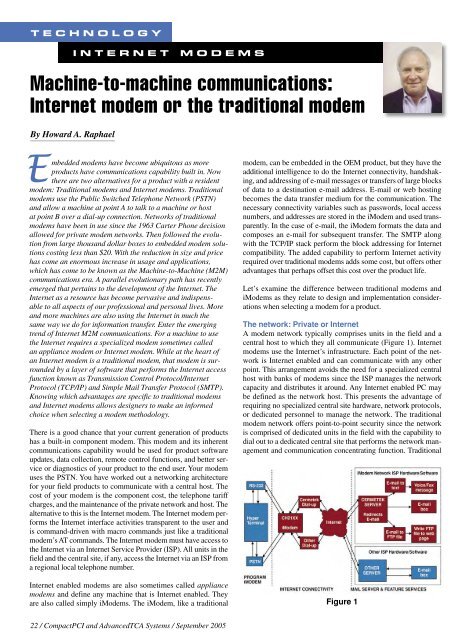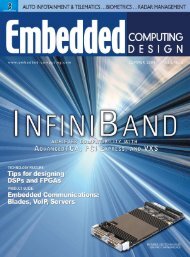CompactPCI and AdvancedTCA Systems - OpenSystems Media
CompactPCI and AdvancedTCA Systems - OpenSystems Media
CompactPCI and AdvancedTCA Systems - OpenSystems Media
Create successful ePaper yourself
Turn your PDF publications into a flip-book with our unique Google optimized e-Paper software.
T E C H N O L O G Y<br />
I N T E R N E T M O D E M S<br />
Machine-to-machine communications:<br />
Internet modem or the traditional modem<br />
By Howard A. Raphael<br />
Embedded modems have become ubiquitous as more<br />
products have communications capability built in. Now<br />
there are two alternatives for a product with a resident<br />
modem: Traditional modems <strong>and</strong> Internet modems. Traditional<br />
modems use the Public Switched Telephone Network (PSTN)<br />
<strong>and</strong> allow a machine at point A to talk to a machine or host<br />
at point B over a dial-up connection. Networks of traditional<br />
modems have been in use since the 1963 Carter Phone decision<br />
allowed for private modem networks. Then followed the evolution<br />
from large thous<strong>and</strong> dollar boxes to embedded modem solutions<br />
costing less than $20. With the reduction in size <strong>and</strong> price<br />
has come an enormous increase in usage <strong>and</strong> applications,<br />
which has come to be known as the Machine-to-Machine (M2M)<br />
communications era. A parallel evolutionary path has recently<br />
emerged that pertains to the development of the Internet. The<br />
Internet as a resource has become pervasive <strong>and</strong> indispensable<br />
to all aspects of our professional <strong>and</strong> personal lives. More<br />
<strong>and</strong> more machines are also using the Internet in much the<br />
same way we do for information transfer. Enter the emerging<br />
trend of Internet M2M communications. For a machine to use<br />
the Internet requires a specialized modem sometimes called<br />
an appliance modem or Internet modem. While at the heart of<br />
an Internet modem is a traditional modem, that modem is surrounded<br />
by a layer of software that performs the Internet access<br />
function known as Transmission Control Protocol/Internet<br />
Protocol (TCP/IP) <strong>and</strong> Simple Mail Transfer Protocol (SMTP).<br />
Knowing which advantages are specific to traditional modems<br />
<strong>and</strong> Internet modems allows designers to make an informed<br />
choice when selecting a modem methodology.<br />
There is a good chance that your current generation of products<br />
has a built-in component modem. This modem <strong>and</strong> its inherent<br />
communications capability would be used for product software<br />
updates, data collection, remote control functions, <strong>and</strong> better service<br />
or diagnostics of your product to the end user. Your modem<br />
uses the PSTN. You have worked out a networking architecture<br />
for your field products to communicate with a central host. The<br />
cost of your modem is the component cost, the telephone tariff<br />
charges, <strong>and</strong> the maintenance of the private network <strong>and</strong> host. The<br />
alternative to this is the Internet modem. The Internet modem performs<br />
the Internet interface activities transparent to the user <strong>and</strong><br />
is comm<strong>and</strong>-driven with macro comm<strong>and</strong>s just like a traditional<br />
modem’s AT comm<strong>and</strong>s. The Internet modem must have access to<br />
the Internet via an Internet Service Provider (ISP). All units in the<br />
field <strong>and</strong> the central site, if any, access the Internet via an ISP from<br />
a regional local telephone number.<br />
Internet enabled modems are also sometimes called appliance<br />
modems <strong>and</strong> define any machine that is Internet enabled. They<br />
are also called simply iModems. The iModem, like a traditional<br />
modem, can be embedded in the OEM product, but they have the<br />
additional intelligence to do the Internet connectivity, h<strong>and</strong>shaking,<br />
<strong>and</strong> addressing of e-mail messages or transfers of large blocks<br />
of data to a destination e-mail address. E-mail or web hosting<br />
becomes the data transfer medium for the communication. The<br />
necessary connectivity variables such as passwords, local access<br />
numbers, <strong>and</strong> addresses are stored in the iModem <strong>and</strong> used transparently.<br />
In the case of e-mail, the iModem formats the data <strong>and</strong><br />
composes an e-mail for subsequent transfer. The SMTP along<br />
with the TCP/IP stack perform the block addressing for Internet<br />
compatibility. The added capability to perform Internet activity<br />
required over traditional modems adds some cost, but offers other<br />
advantages that perhaps offset this cost over the product life.<br />
Let’s examine the difference between traditional modems <strong>and</strong><br />
iModems as they relate to design <strong>and</strong> implementation considerations<br />
when selecting a modem for a product.<br />
The network: Private or Internet<br />
A modem network typically comprises units in the field <strong>and</strong> a<br />
central host to which they all communicate (Figure 1). Internet<br />
modems use the Internet’s infrastructure. Each point of the network<br />
is Internet enabled <strong>and</strong> can communicate with any other<br />
point. This arrangement avoids the need for a specialized central<br />
host with banks of modems since the ISP manages the network<br />
capacity <strong>and</strong> distributes it around. Any Internet enabled PC may<br />
be defined as the network host. This presents the advantage of<br />
requiring no specialized central site hardware, network protocols,<br />
or dedicated personnel to manage the network. The traditional<br />
modem network offers point-to-point security since the network<br />
is comprised of dedicated units in the field with the capability to<br />
dial out to a dedicated central site that performs the network management<br />
<strong>and</strong> communication concentrating function. Traditional<br />
Figure 1<br />
22 / <strong>CompactPCI</strong> <strong>and</strong> <strong>AdvancedTCA</strong> <strong>Systems</strong> / September 2005

















